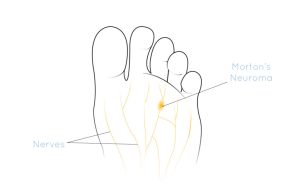Ankle Instability
Ankle Instability
An ankle sprain is an injury to one or more ligaments in the ankle, usually on the outside of the ankle. Ligaments are bands of tissue, like rubber bands, that connect one bone to another and bind the joints together. In the ankle joint, ligaments provide stability by limiting the side to side movement.
Causes of ankle instability:
The ankle is held together by three main ligaments. The two outer ligaments stop the ankle sliding forward and rolling from side to side. They are attached to the fibula (the small bone next to the shinbone) and the talus (the anklebone).
When the ankle is violently twisted or forced beyond its normal range of movement, the ligaments can easily become stretched or torn. This is known as an “ankle sprain”.
If your ankle doesn’t heal properly after a sprain, or you sprain your ankle repeatedly, you may end up with chronic ankle instability. The result of constant swelling in the ankle can cause a reflex in the body that ‘switches off’ the muscles around the joint. This reduces the ankle stability even more.
Symptoms of ankle instability:
The sensation that your ankle is going to give way, especially on uneven ground is a common sign of ankle instability. Your ankle will frequently turn during activity causing pain, inflammation and swelling. Symptoms may include:
- Pain and soreness
- Swelling
- Bruising
- Difficulty walking
- Stiffness in the joint
Diagnosing ankle instability:
-
To help diagnose ankle instability an x-ray may be recommended to rule out a fracture of the ankle bones. Putting stress directly on the ankle ligaments ascertains if the ankle has become unstable; it can also help to show if a ligament has been torn.
In evaluating your injury, the specialist will obtain a thorough history of your symptoms and examine your ankle. X-rays or other advanced imaging studies may be requested to help determine the severity of the injury. An MRI may be suggested if surgery is advised.
Treating ankle instability:
Following an assessment and possible imaging of the ankle, your specialist may advise on one or more of the following conservative treatments:
- Physiotherapy – Physio may be suggested to help strengthen the ankle region. This can retrain the ankle muscles to correctly balance and improve range of motion.
- Immobilisation – Your specialist may advise on immobilisation. They may provide you with an ankle brace, crutches and/or a boot whilst the region is healing.
- Steroid injections – Ultrasound guided steroid injections may be suggested for an ankle sprain to reduce swelling and promote healing.
Surgery for ankle instability:
Should conservative treatments fail to improve conditions, your specialist may advise on surgery.
The brostrom gould procedure aims to repair underlying damage to the ankle ligament and improve instability.
Following this procedure, you will typically require a backslab cast for the first two weeks postoperative.. Your surgeon will then provide you with an aircast boot to mobilise in between 2-6 weeks postoperative. You may require 8 weeks off from sedentary work or 10 weeks for manual work.
Find out information on injuries that can result from running
Frequently asked questions
Chronic ankle instability can be treated with ankle braces, orthotics, injection therapy and surgery. It will depend on what the severity of the underlying problem is and what treatments you have tried in the past.
Some people can be biologically hypermobile, which means they are very flexible. This can also lead to instability. Most of the time however, ankle instability is caused by an injury where the ligaments around the ankle are damaged leading to instability.
Symptoms include repeated ankle injuries due to the instability, or alternatively aching and burning symptoms in the ankle brought on by walking and exercise.
Related Blogs
Thoughts and advice on foot health care from the Podogo team.


















































